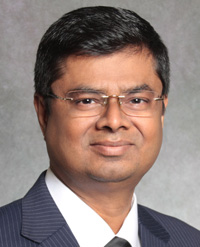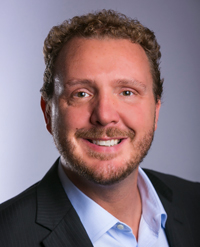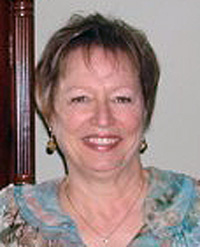
Moderator: My name is Heather Courneya. I am pleased to serve as the moderator for this session, Retirement Planning, presented by our member panel from around the globe. Please help me welcome Rajesh, Helen, Anne-Marie, and Jason. We’re going to start with Jason Smith, who will go through the known facts of the case and present how it would be handled in the United States by him.
Smith: I’m going to cover the facts of the case that MDRT presented to us. They gave us the latitude or flexibility to put our own spin on it based on country and what our own individual philosophies and strategies are.
Here is the information on the case that was presented to us. We have a husband, age 63, and a wife, 61, married 40 years. They expressed they would like to retire in two years. All income and account values are before taxes. So we’re not taking tax into consideration in this case study. When they retire, they’d like to receive $120,000 a year before taxes.
The assets are as follows: The wife has a company pension with spousal continuation, which will provide an income of $1,000 per month. They have an investment real estate property valued at $150,000, which currently provides $1,000 a month. They have accumulated investable assets of $800,000, and the husband has an accumulation contract that will pay out a lump sum of $100,000, when he decides to retire.
The husband and wife will each receive government benefits, like social security in the US, equal to $1,500, for a total of $3,000 per month. They have $75,000 in emergency savings, and their residence is worth approximately $300,000 currently.
These are the facts of the case. Now I’m going to switch hats a little bit and show you some of the tools and strategies that I utilized to build the case study or how I would do it in the US.
First of all, we use a tool called the “income gap assessment.” In this case, you can see the top. [visual] The income we’re trying to replace is $120,000. The fixed income in retirement is the second section, and that’s where I plugged in all the case facts that were provided by MDRT, such as the pensions and the income from the real estate as well as the social security income.
Now, the social security income: It was provided that each would receive $1,500 or $3,000 total. I assumed that that was at full retirement. And in this case study, I made the assessment even though their goal was to retire in two years. They did not have sufficient assets, in my opinion, to retire in two years. So I have them retiring in four years when they turn 65 and 67. Remember, they’re at 61 and 63.
In the US, they are eligible for retirement medical coverage once they turn 65, so I needed the youngest spouse to be 65. And this case worked out at their retiring at 65 and 67.
So you can see the bottom, ultimately, the income gap. [visual] The goal was $120,000 of income. They had approximately almost $60,000 of fixed income that was supplied, so we had an income gap of approximately $60,000. Now, when I do a retirement income plan, I position it into buckets: “Now,” “Soon,” and “Later” Buckets. The Now Bucket is basically that emergency savings. It’s the money that we’re going to leave in the bank. The Soon Bucket is where we’re going to draw the income from in the first phase of retirement. And the Later Bucket is the long-term growth money as well as where we’re going to do life insurance and other legacy planning strategies.
So, when we do a Bucket Plan, we always score the two buckets separately. We don’t score the money in the bank. This is our risk assessment questionnaire. [visual] For the Soon Bucket, they scored “stable,” meaning they did not want to take a lot of risk; they wanted stable income. In the Later Bucket, they scored “growth.”
The assumption that I plugged into the Now Bucket is their $75,000 emergency fund. For the Soon Bucket, I’m assuming a 3 percent rate of return—very conservatively, as they scored “stable.” We’re putting $593,000 and change in the Soon Bucket. That’s going to grow to $668,000 in four years of deferral. Remember, they’re going to retire in four years.
In the Later Bucket, we’re going to assume a conservative 6 percent growth rate on $206,000. That’s going to go into a growth account to obtain the 6 percent growth rate. That should grow to $260,000 in approximately four years.
Now, in 10 more years—and you’ll understand this in a moment—this is when the Soon Bucket would expire, which would grow to $466,000 in the Later Bucket. Now $100,000 will be their accumulation contract that will be received in four years from now, paid at retirement. And that should grow to $179,000 in 10 more years in the Later Bucket. And then, for their home value, I’m going to project a 2 percent annual rate of return, which in four years should grow to $324,000 and in 10 years to $395,000.
Now let’s actually see it in action. In 2018, they’re 63 and 61. This is currently. They have $75,000 in the Now Bucket. They have an income gap of $59,000. We’re going to times that by 10 years, and that’s how we’re going to build out how much money we’re going to put in the Soon Bucket in a stable account. The rest of the money is going to go into the Later Bucket. So that’s the rest of the investable assets as well as the accumulation contract and the home value.
So, money in the bank in the Now Bucket. We’re going to use an annuity or some type of stable account in the Soon Bucket. And then it’s going to be growth assets in the Later Bucket. The accumulation contract cannot be invested for four more years when they retire. So we have a total of $1.275 million of assets.
Four years from now, in 2022, they’re going to retire—they’re now 67 and 65 years old. That $1.275 million should have grown to $668,000 in the Soon and $685,000 in the Later, so now it’s grown to $1.4 million, assuming 3 percent growth in the Soon Bucket and 6 percent growth in the Later Bucket. They’re now retired and going to start drawing from their Soon Bucket for income purposes.
The accumulation contract now gets invested into a growth account because it’s available at retirement. Ten years from now, they will have drawn all the money down out of the Soon Bucket. And so now they still have the Now Bucket, and the Later Bucket will have grown to $1,041,000. At this point, they are 77 and 75 years old, 10 years later. We’re now going to reload the Soon Bucket to be able to draw more income. So all the assets get reloaded other than the home value. We still have a total of $1.1 million, and we have 10 years in the Soon Bucket to provide income, which will take them to 87 and 85 years old. Then, at that point if need be, if they’re still alive, they’ll be able to draw from the Later Bucket, from which they can access something called a home equity line of credit in the US, where they can go ahead and access the value of their home value at 87 and 85 years old, assuming they live that long and the Soon Bucket has expired. And that concludes how I would do the case study.
Chheda: I bought this paper, the Wall Street Journal, and last week it said that a time bomb looms for aging America. Shocking. It says that more than 40 percent of households headed by people aged 55 through 70 lack sufficient resources to maintain their living standard in retirement. What I mean to say here, before I move on to Asia and references to India, is if something is here, the same thing applies to us, too, in the near future.
In India, around 1947 when it got independence, the life expectancy was 32 years. Today, it is officially 68, but none of our clients are the average clients who retire at 58 and in 10 years have an appointment with their maker. For 90 percent of them, one of the spouses will cross 90. This is one realization that I would like to share. And coming to the example as a case study, I may talk in rupees, and I will assume that Indian inflation is on the higher side at 4 and 5 percent. Returns are a double digit 10 and 12 percent. So, quickly, I would immediately convert everything as soon as they retire into an immediate annuity plan.
What it means is that, in the Indian context, usually the wife is a dependent. So taking that constant, what if tomorrow she loses her husband? We had a conference where it said that 80 percent of men die married and 80 percent of women die widowed. So, if that is the statistic, she needs some regular income.
So what I have done is this: In the first option, the wife has a company pension with spousal continuation, which will provide an income of $1,000 a month. The second is, they have an investment real estate property, which currently provides $1,000. I say to sell the property and immediately convert it to $1,500 a month because it could be very challenging situation to sell later on. And it says that it’s investment real estate property. You could do that when you’re younger, not when you reach retirement. So that’s the time you cash it out.
The third is that they have accumulated investable assets of $800,000. I am going to withdraw $4,000 a month at 6 percent. That’s a systematic withdrawal plan. The fourth one is, the husband has an accumulation contract that will pay a lump sum of $100,000. I converted that to $1,000 a month. And the last one is social security benefits of $1,500 a month for each of them—that’s $3,000. So $1,000 plus $1,500 plus $4,000 plus $1,000 plus $3,000 is equal to $10,000. It’s done. So simple. Not so.
Here, $10,000 a month is today. What I have plugged in is in case there is a shortfall beyond 20 years. In India recently, there is something called a reverse mortgage that has been introduced, so they could do that for their house. I assume that they don’t have children or the children are independent. Or they could leave the balance as a legacy to their charity of choice. And in case they’re still falling short, that’s the time they can touch the $800,000, generally in about 20 years or so, a differential of 3 percent if they withdraw it at 6 percent. And the yield is 9 percent.
In the last 30 years, an equity return of the index in India has given 15 percent. I’m not talking of 15 percent; I’m cutting it down to 9 percent. So that could double that amount, and it could give them a good solution. That is my viewpoint.
Jenkins: So the couple has come to me and said they want $120,000 a year. The first thing I looked at was what they have as a guaranteed income. And the guaranteed income totals the £60,000 that Jason referred to earlier. I looked at the spouse continuation because I’ve done my calculations based on the two of them being alive. But I would question, at some stage, what happens if one person dies? Because part of that guaranteed income disappears at that stage.
The next thing I looked at immediately was the shortfall of £60,000. They have the buffer of £75,000, which is quite similar to your bucket. And then they have the £100,000 at retirement for the husband. We do what we call a cash flow analysis. So we take the £800,000 that they have to invest for income and we ask, how long will that last?
I did it in two stages: £60,000 level and £60,000 inflation. The inflation rate I used was 2.5 percent, and the growth rate was 5 percent. And, oddly enough, I came to the same conclusions as Jason. In the first stage, on the increasing basis, it would run out at age 81 and at age 86, if it remains level.
I went to the Rolling Stones concert in my home city of Cardiff just before coming here, and they were singing “You Can’t Always Get What You Want.” And I feel for this couple.
So my question to them would be: Where did the £120,000 come from? Do you really need that? Or can we phase that as time goes on? Because this money, if we invest it or whatever we do now, is likely to run out.
We do a life expectancy, and I was talking to the group earlier, and I was referred to this book called The 100-Year Life. I highly recommend it, because it talks about how life is going to change in the very near future, how we need to deal with retirement planning, and how we need to deal with our working lives and changing careers. The authors are Linda Gratton and Andrew Scott.
A few things I would also want to find out from this couple are what their attitude to risk is, which is what we’ve looked at, and then, do they need capital for anything in the future? Can we invest the whole of this £800,000, or are there some lump-sum requirements? And what are their hobbies? I want to find out a bit more about them. What are their plans for retirement? Where did this figure of £120,000 come from? Is it realistic?
And then I’d also look further at estate planning because we have taxes when someone passes away. So I want to look at that as part of the planning. The money might run out, which is good for tax planning but not good if they can’t continue to live. I also feel that if they’d come to me two years before retirement, that’s too late. We need to instill in people that we’ve got to start talking as early as possible.
And then the last resort again is, we would look at the property. This is the last resort because we can extract income from that, but that possibly isn’t the ideal thing to do. Because the funny thing about needing income in retirement at their ages is, they’re going to want to travel the world and go out and eat. But as they get older, their care needs are going to become greater, and they may need even more money. So you need it when you retire. Then there’s a little bit of a gap where people become more passive and then the care needs become much more expensive and needed. So that’s my solution.
Lee: In my assumptions, and, actually, my results came up quite similar to what Jason’s were in the case scenario based on the fixed incomes that they had in Singapore. The good thing in Singapore is, we don’t have estate taxes, and we don’t have capital gains taxes. So, therefore, whatever they invest, and if they were to liquidate any of the assets, whatever the benefit could be added into their income. This is based on the case scenario where in Singapore we don’t really have state pensions. So, I only question that based on their ages—those of you who are my Singapore colleagues will know this. Actually, we do have something called a “central providence fund.” And actually, based on their ages, the CPF minimum sum wouldn’t give them $1,500. So I’ve only assumed that they have topped it up.
But if we assume all the income that we’re told they have, it does come up to a shortfall, a potential shortfall, that they have to fulfill of almost $60,000, and with this, my concern is that to want to retire in two years’ time is a very short time horizon. If I assume that the $800,000 is investable assets, the question I would also ask is, What is the attitude to what risk? Because, unfortunately, if I did an analysis of drawing down similar to Helen and Jason, they don’t have enough money if I assume a life expectancy of up to 85. Therefore, they will run out of money.
With this, the concern therefore is, what is their risk at the time? Because, unfortunately, in Singapore, we don’t have annuities that are indexed to any investments. Most of the annuities in Singapore are based on interest rates, which are pathetic at the moment. Therefore, annuities and keeping cash to fund their retirement income isn’t a viable solution. The only solution is that hopefully they have a risk appetite to consider at least investing 60 to 70 percent of the $800,000 in order for it to be able to generate the returns to provide for their continued income until age 85.
So the $75,000 will be the immediate cash asset as an emergency. But the question will be, what is their risk appetite? Have they considered the impact of inflation? In Singapore, I always use an assumption of about 2 to 3 percent. I would also question the accumulation contract of $100,000 and I would suggest, because it’s supposed to come out every time and would probably be the cash they would fall back on first so that they can then tap the $800,000 for a slightly longer-term investment, using a horizon of at least five years and beyond.
I would ask the question as to whether, at this point in time, even though it’s only another two years, they have additional surplus cash from their income that they can top up for their investments to make up for the shortfall.
They need to look at the investment property that they’re drawing income from now and see whether the property is going to appreciate in value. It might be more worth their while to sell it and, if not, certainly to review the rental income that they’re getting from the property to see if they can get more cash out of it to add on to their income.
At the end of the day, the last alternative similarly in my assessment would be to fall back on their residential property, if need be, on the back end to either reverse mortgage it or to capitalize on the value of the property and possibly look at downgrading if they need to. Although, frankly, at that price in Singapore, because our property prices are very high, they’re not going to be able to get very much.
Moderator: Thank you, everyone, for sharing your thoughtful ideas. Now we have some time for questions.
Question: I was just wondering if all four of you came to the same conclusion, which makes perfect sense, by the way. I completely agree with everything you’ve come to conclusions on. Did you not have the ability to adjust the goal? My natural inclination would have been to say, “You’re going to be financially independent at, let’s say, $90,000 a year in two years. Can you live on that?” Or was the case study given to you in such a way that, no, you have to get to $120,000 no matter what?
Smith: We were given a lot of flexibility, and so, individually, I think we did have the choice to choose whether to dial down the required income from $120,000 to $90,000. Or to lengthen the time before they could retire like I did in my scenario of going four years. And then it was feasible to hit the goal of $120,000.
Chheda: I’d like to add something. The other concept is, we are going to have a workshop area. We have done it in such a way like an open architecture so that at this Round Table, when you interact, you could have your presumptions or whatsoever you like. But, ultimately, it drives home the point of an exchange. It’s a very big challenge across countries—taxation, life expectancy, understanding, and so on and so forth.
Lee: I think most of us used that $120,000, and the solutions therefore give the conclusion as to whether we think they could meet it or not. So the reality is that they would either have to dial down or retire later.
Question: Were they also given the opportunity to save more over the next two years so that you could calculate that?
All: No.
Lee: I said I would ask them the question of whether they have additional surplus income so that they could save more because they have a shortfall.
Question: I would just add a little assumption for this because the couple is supposed to retire in their own home country. But, nowadays people are moving around the world, so what if they retire, for example, in Thailand or somewhere else or whatever? What’s your suggestion for this kind of retirement plan?
Chheda: There is an example we have in India of a family in the UK who comes during their winter months to India. It’s warmer as well as much cheaper for the six months of retirement where they can afford to have maid servants and everything for themselves. And this is also a very good question because cross border, there are a lot of opportunities to search for. I have a few clients who even thought of retiring from North America to South America. Probably they have been to a couple of places. This could also be a good alternative when there is a challenge of money or especially health issues. There are lower health costs in a country like India; the same health care could cost 100 to 1,000 times in another country like the US.
Lee: In Singapore, increasingly that is what many couples considering. The trend, I think, in Singapore is that people look to retire in Malaysia because of housing costs and the exchange rate, which is in our favor. Similarly, I know some friends who have retired in Phuket, Thailand, because there, with the money of what they will pay for property, they can live like a king, and the cost of living, food, overall. The point that you raised is a very valid one. The only other way to meet their gap would be to consider retiring in a country where the cost of living is far less. However, they would have to be mindful, obviously, of things like health and taxes. Because some of the benefits that we have in Singapore are no estate taxes and our taxes are relatively low.
Jenkins: Some people in the UK will go to Spain for the winter, but they would stay in a hotel for that period because of the problem with retiring overseas, even if you’re very used to the country, is that your family very often is still back home, and so you miss them. And if one of the partners passes away, then loneliness becomes a great thing. To relocate, probably back to the UK, where health care is cheaper and better and more needed, the problem reverses itself again. So I could encourage people to probably go for a short time at first or to rent before they really make that decision to relocate.
Smith: Quality of health care and family and friends are the two big factors on that.
Question: I started 14 years ago, and I met more than 20 percent of my clients, who are older. About 80 percent of my clients at that time were very young. I ended up giving retirement plans to all of my clients, to young clients and to older clients. I have developed a clientele of 2,000 retirement policies, retirement clients. It’s interesting that you discussed this just now. These clients have an amazing number of years for them to plan for retirement. So I made sure, foreseeing the problem, that all my clients have retirement policies starting from 20 years onward. And that was one of the reasons that I could become an MDRT member, apart from the core work I do on corporate insurance.
Jenkins: Can I make a point on that? A lot of people assume, a lot of our clients will assume, that they will inherit from their parents, and therefore they might look at that as retirement planning. But you can never assume anything. So I never encourage that. But I read recently in a newspaper article that in the UK, baby boomers’ properties have gone up enormously. And so when the baby boomers pass away, there is going to be a lot of money going back into the system. But, strangely enough, because of good health and a good life, they are living longer, like in the 100-year range. So, actually, their children will not benefit. Their children are going to be in their 60s or 70s possibly when they’re gone. It’s going to be the grandchildren potentially who are going to inherit. So we have to change our mindset about retirement and all the other things that go with it.
Smith: To your point, if the children are in their 60s or 70s, they may live another 50 years at that point.

Anne-marie Lee, ChFC, CLU, is a 20-year MDRT member who has served on several committees, including the Program Development Committees for three Annual Meetings, multiple terms in the Membership Communications Committee (MCC), and DVP of the Client Strategies Division for 2017. She has also been featured in industry magazines in Indonesia, Thailand and Taiwan. She is very active in local and international industry organizations such as the Insurance and Financial Practitioners Association of Singapore (IFPAS).

Rajesh Chheda, ACA, CFP, is a 15-year MDRT member with two Court of the Table and three Top of the Table qualifications who has been in the financial services profession since 1990. In that time, he has evolved into a later-life planner, focusing on retirement planning and health risk management.

Helen A. Jenkins, Dip PFS, is a 29-year MDRT member with nine Court of the Table qualifications. The managing director of Inspiration Wealth Management, Jenkins was shortlisted for Women in Finance’s Financial Advisor of the Year in 2017. Her knowledge of and passion for helping women look after themselves from an early age comes from Jenkins being raised by her mother and grandmother in Wales. She is also the U.K. chapter president of the Circumnavigators Club and assistant treasurer of Welsh Women Walking.

Jason L. Smith is a 12-year MDRT member with one Court of the Table and 11 Top of the Table honors. A nationally-acclaimed speaker, financial planner, author, coach and entrepreneur, Smith is the founder of a holistic financial services practice; a financial training, coaching and IP development organization; and two national financial services organizations. His most recent book, “The Bucket Plan,” is a bestseller with praise from national media. Smith was named Top 40 under 40 by InvestmentNews magazine in 2015. His mission is to simplify financial planning for one billion people worldwide.

Heather M. Courneya, CLU, CH.F.C., is a 19-year MDRT member with nine Court of the Table qualifications. She served on the Program Development Committee for the 2015 Annual Meeting and spoke in the ConneXion Zone at the 2017 Annual Meeting.